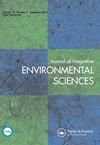乌克兰的跨界河流:可持续发展和清洁水的前景
IF 3.5
4区 环境科学与生态学
Q3 ENVIRONMENTAL SCIENCES
Journal of Integrative Environmental Sciences
Pub Date : 2021-01-01
DOI:10.1080/1943815X.2021.1930058
引用次数: 9
摘要
跨界河流流域占全球河流流量的一半以上,容纳了全球40%的人口。乌克兰是流经十多个欧洲国家的四大跨境河流的一部分,由于人类在上游和下游地区的活动而面临污染问题。乌克兰政府呼吁采取行动,实现可持续发展目标6 (SDG6),并整合欧盟水资源立法。本文讨论了乌克兰减少跨界河流污染的五个可持续发展前景。这些观点涉及(1)从行政河流管理(2017年之前)到流域管理(2017年之后)的过渡,以加强国家间的合作;(2)跨学科和(3)跨学科研究,以更好地了解河流污染的原因和影响,并探索解决方案;(4)与水有关的基础设施的创新和现代化;(5)社会意识。未来的研究可以集中在乌克兰的例子上,并采用这五种观点来支持制定解决方案,以实现可持续发展目标6,并支持跨界河流的可持续流域管理和欧盟水立法的一体化。图形抽象本文章由计算机程序翻译,如有差异,请以英文原文为准。
Transboundary rivers of Ukraine: perspectives for sustainable development and clean water
ABSTRACT Transboundary river basins are responsible for over half of the global river discharges and accommodate 40% of the global population. Ukraine is part of the four large transboundary rivers that flow through more than ten European countries and experience pollution problems because of human activities in up-and downstream areas. The Ukrainian government calls for actions to achieve Sustainable Development Goal 6 (SDG6) and integrate the European Union water legislation. This paper discusses five sustainable development perspectives for Ukraine to reduce pollution in transboundary rivers. These perspectives relate to (1) transitions from administrative river management (before 2017) to river basin management (after 2017) to enhance cooperation between countries, (2) interdisciplinary and (3) transdisciplinary research to better understand the causes and effects of river pollution and explore solutions, (4) innovation and modernization of water-related infrastructures and (5) the societal awareness. Future research could focus on the example of Ukraine and the adoption of these five perspectives to support the formulation of solutions to achieve SDG6 and support the sustainable basin management of transboundary rivers and the integration of European Union water legislation. Graphical abstract
求助全文
通过发布文献求助,成功后即可免费获取论文全文。
去求助
来源期刊

Journal of Integrative Environmental Sciences
ENVIRONMENTAL SCIENCES-
CiteScore
3.90
自引率
0.00%
发文量
13
审稿时长
>12 weeks
期刊介绍:
Journal of Integrative Environmental Sciences (JIES) provides a stimulating, informative and critical forum for intellectual debate on significant environmental issues. It brings together perspectives from a wide range of disciplines and methodologies in both the social and natural sciences in an effort to develop integrative knowledge about the processes responsible for environmental change. The Journal is especially concerned with the relationships between science, society and policy and one of its key aims is to advance understanding of the theory and practice of sustainable development.
 求助内容:
求助内容: 应助结果提醒方式:
应助结果提醒方式:


